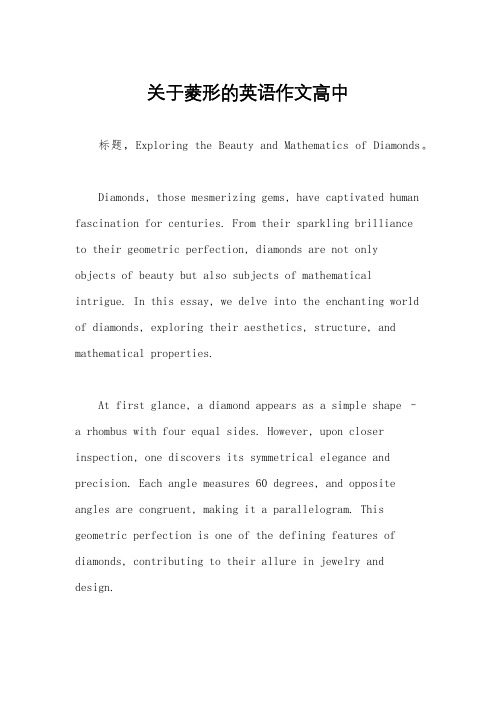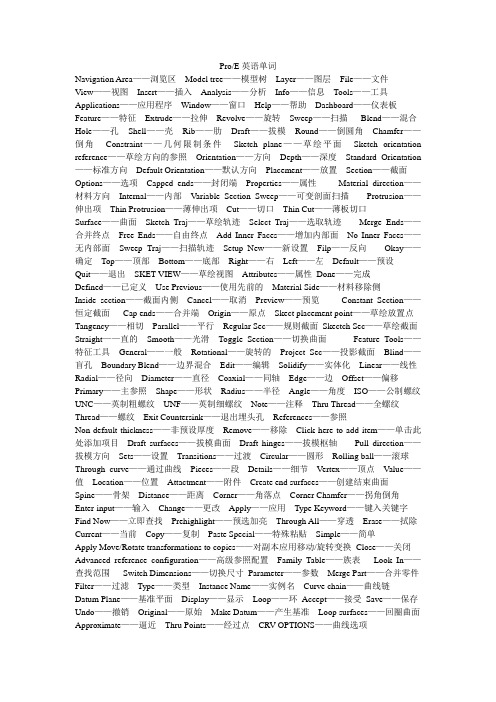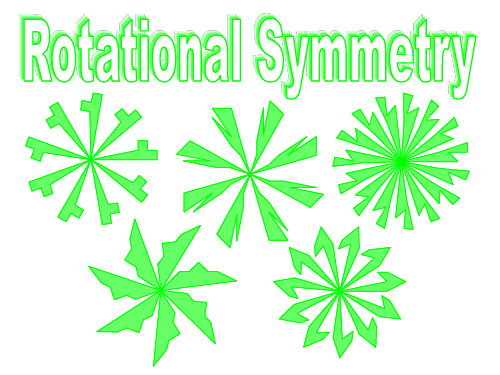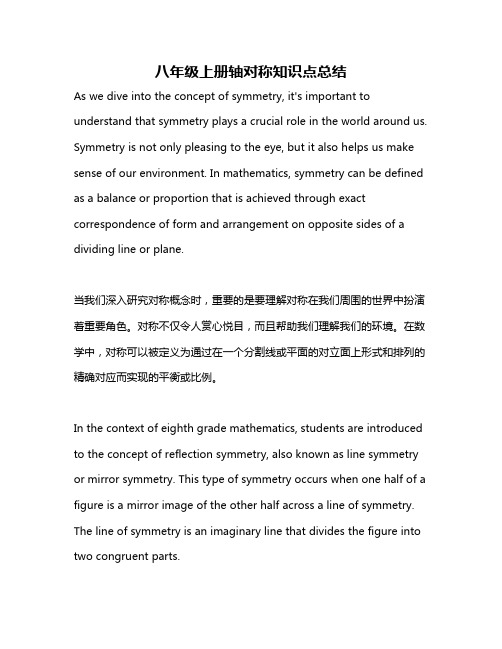Rotational and line Symmetry
《轴对称图形》跨学科活动方案

《轴对称图形》跨学科活动方案English Response:Introduction:Cross-curricular activities that integrate different subject areas provide students with a comprehensive and engaging learning experience. One such activity thatfosters interdisciplinary connections is the exploration of symmetry, particularly in the context of axisymmetric shapes. This activity combines mathematical concepts, artistic expression, and critical thinking skills.Learning Objectives:Understand the concept of symmetry, specifically axisymmetric shapes and their transformations.Apply mathematical formulas and principles to determine the properties of axisymmetric shapes.Develop artistic skills by creating symmetrical designs inspired by mathematical concepts.Foster critical thinking and problem-solving abilities through the analysis and interpretation of symmetrical forms.Materials:Drawing paper.Markers or crayons.Ruler.Compass.Protractor.Copies of images or objects with axisymmetric shapes for observation and analysis.Procedure:Part 1: Mathematical Exploration.Introduce the concept of symmetry and axisymmetric shapes.Students use rulers, compasses, and protractors to draw and measure various axisymmetric shapes, such as circles, ellipses, spheres, and cones.They apply mathematical formulas to determine the radius, diameter, circumference, area, and volume of these shapes.Students investigate the properties of axisymmetric shapes, such as rotational symmetry and the relationship between the degree of symmetry and the number of axes of symmetry.Part 2: Artistic Expression.Inspired by the mathematical concepts explored, students create symmetrical designs on drawing paper.They use markers or crayons to draw patterns, shapes, and images that exhibit axisymmetric symmetry.Students can fold and cut paper to create three-dimensional symmetrical designs.Part 3: Critical Thinking and Analysis.Students observe and analyze images or objects with axisymmetric shapes.They identify the axes of symmetry, degree of symmetry, and any mathematical principles that apply to the shapes.Students present their findings to the class, discussing the mathematical and artistic aspects of the symmetrical forms.Assessment:Student drawings and designs.Class discussion participation.Written or oral presentations on the analysis of axisymmetric shapes.跨学科活动方案。
关于菱形的英语作文高中

关于菱形的英语作文高中标题,Exploring the Beauty and Mathematics of Diamonds。
Diamonds, those mesmerizing gems, have captivated human fascination for centuries. From their sparkling brillianceto their geometric perfection, diamonds are not onlyobjects of beauty but also subjects of mathematical intrigue. In this essay, we delve into the enchanting world of diamonds, exploring their aesthetics, structure, and mathematical properties.At first glance, a diamond appears as a simple shape –a rhombus with four equal sides. However, upon closer inspection, one discovers its symmetrical elegance and precision. Each angle measures 60 degrees, and opposite angles are congruent, making it a parallelogram. This geometric perfection is one of the defining features of diamonds, contributing to their allure in jewelry and design.Beyond their aesthetic appeal, diamonds possess remarkable mathematical properties. One of the most intriguing aspects is their symmetry. Diamonds exhibit various types of symmetry, including reflection symmetry and rotational symmetry. Reflection symmetry means that a shape can be divided into two identical halves by a line. In a diamond, this is evident when you draw a line from one corner to its opposite corner – the two resulting halves mirror each other perfectly. Rotational symmetry refers to the ability of a shape to be rotated by a certain angle and still look the same. A diamond has rotational symmetry of order two, meaning it looks the same when rotated by 180 degrees around its center. These symmetrical properties not only enhance the visual appeal of diamonds but also play a crucial role in their classification and evaluation in the gem industry.Moreover, diamonds are intricately connected to the field of geometry, particularly in the study of polyhedra.A diamond can be seen as a three-dimensional shape known as a rhombic dodecahedron. This polyhedron consists of 12 rhombus-shaped faces, with three meeting at each vertex.Its symmetrical structure and geometric properties have fascinated mathematicians and artists alike, inspiringworks of art and architectural designs.The mathematical fascination with diamonds extends beyond their shape and symmetry to their optical properties. Diamonds are renowned for their ability to refract and disperse light, resulting in their characteristicbrilliance and fire. This phenomenon is governed by the principles of physics and mathematics, particularly Snell's law of refraction and the theory of total internal reflection. By understanding these principles, scientists and gemologists can predict and enhance the optical performance of diamonds, ensuring their maximum beauty and value.In addition to their mathematical allure, diamonds have played a significant role in human culture and history. As symbols of wealth, power, and love, diamonds have adorned royalty, inspired poets, and fueled exploration and trade throughout the ages. From the legendary mines of Golcondato the modern laboratories producing synthetic diamonds,the story of diamonds is intertwined with human ingenuity, ambition, and creativity.In conclusion, diamonds are not merely dazzling gems but also fascinating objects of mathematical inquiry. Their symmetrical beauty, geometric perfection, and optical properties have captivated minds for centuries, inspiring exploration and admiration across cultures and disciplines. Whether adorning a piece of jewelry or sparking curiosityin a classroom, diamonds continue to shine as symbols of both natural wonder and mathematical elegance.。
symmetric 名词

Symmetric1. IntroductionSymmetric is a term used in mathematics and other fields to describe objects or concepts that possess a certain type of symmetry. In mathematics, symmetry refers to a property where an object remains unchanged under certain transformations, such as reflection, rotation, or translation. In this article, we will explore the concept of symmetry and its various applications in different disciplines.2. Symmetry in MathematicsSymmetry plays a fundamental role in mathematics and is widely studied in various branches, including geometry, algebra, and group theory. In geometry, symmetric objects are those that can be divided into two or more parts that are mirror images of each other. For example, a circle is symmetric with respect to any line passing through its center.Symmetry can also be observed in patterns and shapes. Regular polygons such as squares and equilateral triangles possess rotational symmetry because they can be rotated by certain angles without changing their appearance. Fractals, which are intricate mathematical patterns that repeat at different scales, often exhibit self-similarity and possess various types of symmetries.In algebra, symmetry is explored through the concept of functions. A function is said to be symmetric if it satisfies the condition f(x) =f(-x) for all values of x in its domain. This property implies that the graph of the function is symmetric with respect to the y-axis.Group theory provides a rigorous framework for studying symmetry by defining mathematical structures called groups. A group consists of a set of elements and an operation that combines two elements to produce another element in the set. Symmetry groups describe all possible symmetries of an object or system and play a vital role in understanding its properties.3. Symmetry in PhysicsSymmetry has profound implications in physics and is essential for understanding the laws of nature. The principle of symmetry lies at theheart of many fundamental theories, such as classical mechanics, quantum mechanics, and general relativity.In classical mechanics, the conservation of angular momentum is a consequence of rotational symmetry. The laws of motion remain the same regardless of the direction in which an object is oriented. This symmetry is evident in everyday life, where the behavior of objects under different orientations follows consistent patterns.In quantum mechanics, symmetry plays a crucial role in determining the behavior of particles and their interactions. The principles of quantum field theory rely heavily on the concept of gauge symmetry, which describes the invariance of physical laws under certain transformations. Symmetries such as time translation symmetry and particle-antiparticle symmetry are fundamental to our understanding of elementary particles and their interactions.General relativity, Einstein’s theory of gravity, incorporates the principle of general covariance, which states that physical laws should be independent of the choice of coordinates. This symmetry reflects the idea that space and time are not absolute but rather depend on the observer’s frame of reference.4. Symmetry in BiologySymmetry is prevalent in biology and plays a crucial role in understanding various biological processes and structures. Many organisms exhibit bilateral symmetry, where their bodies can be divided into two mirror-image halves along a plane. This type of symmetry is observed in animals ranging from insects to mammals.Bilateral symmetry provides advantages such as improved mobility and sensory perception. It allows for efficient movement by dividing body parts into corresponding pairs such as legs or wings. It alsofacilitates better coordination between sensory organs located on opposite sides of an organism.Symmetry is also observed at smaller scales within organisms. For example, DNA molecules possess helical symmetry due to their double-stranded structure. Proteins often exhibit internal symmetries that influence their folding patterns and functions.Studying symmetric patterns in nature can provide insights into evolutionary processes and ecological relationships between differentspecies. Understanding how symmetrical structures arise and function can help biologists unravel complex biological systems.5. Symmetry in Art and DesignSymmetry has been a fundamental principle in art and design for centuries. Artists and designers often use symmetrical patterns and compositions to create aesthetically pleasing and visually balanced works.Symmetry can be found in various art forms, including painting, sculpture, architecture, and textiles. The use of bilateral symmetry can create a sense of harmony and orderliness. Radial symmetry, where elements are arranged around a central point, is also frequently employed to achieve balance and visual interest.In modern design, the concept of symmetry has evolved to include asymmetrical compositions as well. Asymmetry introduces a dynamic element by intentionally breaking traditional symmetrical arrangements. This approach adds visual tension and can create a more engaging and thought-provoking experience for the viewer.6. ConclusionSymmetry is a fascinating concept that permeates many aspects of our world, from mathematics to physics, biology, and art. It represents an inherent orderliness and balance that is both aesthetically pleasing and intellectually stimulating.The study of symmetry has led to significant advancements in various fields, providing insights into the fundamental laws of nature, the structure of biological systems, and the principles of design. By understan ding symmetry’s underlying principles and exploring its applications, we gain a deeper appreciation for the intricate patterns that surround us.。
proe英语单词

Pro/E英语单词Navigation Area——浏览区Model tree——模型树Layer——图层File——文件View——视图Insert——插入Analysis——分析Info——信息Tools——工具Applications——应用程序Window——窗口Help——帮助Dashboard——仪表板Feature——特征Extrude——拉伸Revolve——旋转Sweep——扫描Blend——混合Hole——孔Shell——壳Rib——肋Draft——拔模Round——倒圆角Chamfer——倒角Constraint——几何限制条件Sketch plane——草绘平面Sketch orientation reference——草绘方向的参照Orientation——方向Depth——深度Standard Orientation ——标准方向Default Orientation——默认方向Placement——放置Section——截面Options——选项Capped ends——封闭端Properties——属性Material direction——材料方向Internal——内部Variable Section Sweep——可变剖面扫描Protrusion——伸出项Thin Protrusion——薄伸出项Cut——切口Thin Cut——薄板切口Surface——曲面Sketch Traj——草绘轨迹Select Traj——选取轨迹Merge Ends——合并终点Free Ends——自由终点Add Inner Faces——增加内部面No Inner Faces——无内部面Sweep Traj——扫描轨迹Setup New——新设置Filp——反向Okay——确定Top——顶部Bottom——底部Right——右Left——左Default——预设Quit——退出SKET VIEW——草绘视图Attributes——属性Done——完成Defined——已定义Use Previous——使用先前的Material Side——材料移除侧Inside section——截面内侧Cancel——取消Preview——预览Constant Section——恒定截面Cap ends——合并端Origin——原点Skect placement point——草绘放置点Tangency——相切Parallel——平行Regular Sec——规则截面Skectch Sec——草绘截面Straight——直的Smooth——光滑Toggle Section——切换曲面Feature Tools——特征工具General——一般Rotational——旋转的Project Sec——投影截面Blind——盲孔Boundary Blend——边界混合Edit——编辑Solidify——实体化Linear——线性Radial——径向Diameter——直径Coaxial——同轴Edge——边Offset——偏移Primary——主参照Shape——形状Radius——半径Angle——角度ISO——公制螺纹UNC——英制粗螺纹UNF——英制细螺纹Note——注释Thru Thread——全螺纹Thread——螺纹Exit Countersink——退出埋头孔References——参照Non-default thickness——非预设厚度Remove——移除Click here to add item——单击此处添加项目Draft surfaces——拔模曲面Draft hinges——拔模枢轴Pull direction——拔模方向Sets——设置Transitions——过渡Circular——圆形Rolling ball——滚球Through curve——通过曲线Pieces——段Details——细节Vertex——顶点Value——值Location——位置Attactment——附件Create end surfaces——创建结束曲面Spine——骨架Distance——距离Corner——角落点Corner Chamfer——拐角倒角Enter-input——输入Change——更改Apply——应用Type Keyword——键入关键字Find Now——立即查找Prehighlight——预选加亮Through All——穿透Erase——拭除Current——当前Copy——复制Paste Special——特殊粘贴Simple——简单Apply Move/Rotate transformations to copies——对副本应用移动/旋转变换Close——关闭Advanced reference configuration——高级参照配置Family Table——族表Look In——查找范围Switch Dimensions——切换尺寸Parameter——参数Merge Part——合并零件Filter——过滤Type——类型Instance Name——实例名Curve chain——曲线链Datum Plane——基准平面Display——显示Loop——环Accept——接受Save——保存Undo——撤销Original——原始Make Datum——产生基准Loop surfaces——回圈曲面Approximate——逼近Thru Points——经过点CRV OPTIONS——曲线选项Use Xsec——使用剖截面From Equation——从方程Quilt/Surf——面组/曲面Tweak——扭面Optional——可选的Cartesian——笛卡尔坐标Cylindrical——柱坐标Spherical——球坐标Csys——坐标系Chain——链Exact——确切Mirror——镜像Hide original geometry——隐藏原始几何Trim——修剪trimming object——修剪对象Intersect——相交Unlink——断开链接Along direction——沿方向Normal to surface——垂直于曲面Wrap——包络Destination——目的地Center——中心Ignore intersection surface——忽略相交曲面Trim at boundary——在边界Measurements ——量度To Vertex——至顶点Boundary——边界Measurement type——测量类型Open ends——开放终点Copy all surface as is——按原样复制所有曲面Swap—交换Exclude sueface and Fill holes——排除曲面并填充孔Copy as dependent——复制为从属性Join—连接Keep trimming sueface——保留修剪曲面Thin trim——薄修剪Controls——控制Extend——延伸Method——方式Tangent——切线Along Edge=Along Side edge——沿着侧边NormBnd=Normal To Boundary edge—垂直延伸边Automatic Fit——自动拟合Controlled Fit——控制拟合Create side surface——创建侧曲面Expand——延展Replace——替换Should the entities be aligned——点线是否对齐Environment——环境Isometric——等轴侧Constraints——约束Natural——自然Contents——内容Status——状态Pause——暂停Dimension——尺寸Scan Curve——扫描曲线Gtol——几何公差Symbol——符号Surace Finish——表面光洁度Datum Tag——基准标签Annotation——注释Annotation Element——注释元素Save Status——保存状态Reset Status——重置状态Unhide——取消隐藏Smart——智能Save a Copy——保存副本Thicken——加厚Edit Definition——编辑定义Relations——关系式Model Player——模型播放器Fix Model——修复模型Regenerate features—再生特征Show Dims——显示尺寸Display each feature——显示每个特征Model Tree Columns——模型树列Tree Filters——树过滤器Feat Subtype——特征子类型Designate Name——指定名称Width——宽度Ordel——顺序ppress——隐含Highlighted features——加亮特征Confirm——确认Parent/Chlid——父项/子项Child Handing——子项处理Global Reference Viewer——全局参照查看器Part—零件Actions——操作Object——对象Suspend——保留Setup Note——设置注释Pattern——阵列Conflict——冲突Explain——解释Resolve Sketch——解决草绘Failure Diagnostics——诊断失败Axis——轴Edit Definition——编辑参照The system could not construct the intersetion of part and feature.——系统不能构建零件和特征的交截Feature aborted——特征中止Failed to intersect part——交截零件失败Edit Parameters——编辑参数Increment——增量Table——表Placement——放置Toggle Construction——编辑构造Ungroup——分解组Diamona——菱形Square——正方形Triangle——三角形Spiral——螺旋Assembly——组件Drawing——绘图Manufacturing——制造Format——格式Report——报表Diagram——图表Layout——布局Markup——标记Sub-type——子类型Interchange——互换V erify——校验Process Plan——处理计划Common Name——公告名称Use default template——使用预设模板Component Placement——元件放置Connect——连接Mate——匹配Align——对齐Coincident——重合Allow Assumptions——允许假设Set Working Directory——设置工作目录View Manager——视图管理器Explode——分解Style——样式Simp Rep——简化表示No Cross Section——无剖面Plannar——平面Single——单一Top Level——顶级Show X-Hatching——显示剖切线Bill of Materials——材料清单Quantity——数量Contains——包含Specify Template——指定模板Empty——空Browse——浏览Size——大小Portrait——纵向Landscape——横向Inches——英寸Millimeters——毫米Origin——原点Scale——比例Trimetic——斜轴侧Pick From List——从列表拾取Lock View Movement——锁定视图移动Auxiliary——辅助Coordinate Dimension——坐标尺寸Sheet——页面Arrows——箭头Jog——角拐Snap Line——捕捉线Shared Date——共享数据Import——导入Height——高度Categories——类别View visibility——视图可见性Partial View——局部视图Clip——修剪Custom scale——定制比例Wireframe——线框Spacing——间距Modify Line Style——修改线体Phantom——剖视图Sheet Metal——钣金件Store Map——储存映射Line Font——线型Petrieve——检索Show By——显示方式Pick to ordinate——拾取基线Symmetry Line Axis——轴对称线Spline——样条Switch to orinate——切换到纵坐标Cleanup——整理Decimal Place——小数位数With Leader——带引线Text Style Gallery——文本样式库Character——字符Slant angle——斜角Justification——对齐Horizontal——水平Crosshatching——剖切线Margin——边距Nominal value——公称值Upper tolerance——上公差Lower tolerance——下公差Basic——基础Ipspection——检查Witnessline——尺寸界线Dual dimension——双重尺寸Changes to either the current feature's geometry or to some other feature havecaused the references for user-defined transition (No. 1) to be lost.The affected transitions must have their references redefined.Redefine the TRANSITIONS element for the failed feature, and select theTransitions indicated above for redefinition. Reselect lost references.Could not construct feature.Select an edge with CTRL key pressed to add to this set, or create a new set by selecting an edge or a surface.。
机械类英语词汇中英文对照

actuation活动,激励,动作
L
additive附加的,加成的,添加的,添加剂
lag缓缓而行,滞后,落后于,押往监狱,加上外套
adequately充分地
lagos拉各斯,尼日利亚首都
affordable提供得起的
lathe车床
aggregate合计的,集合的
layer层,层次
assembly组合,装配,部件,汇编
atmospheric大气的,空气的
machinability切削加工型,机械加工性能
augment增加,扩大
machineframe机座,机架
austenite奥氏体
machinery机器,机械
austenitize奥氏体化,使成奥氏体
machining机械加工
above all尤其是,最重要的是,首先是
J
abrasion磨损
jacket水套
abut邻接,依靠
jerky急拉的,急动的
accessory附件
journal bearing滑动轴承
accommodate使适应
K
acetylene乙炔,电石气
kerosene煤油
activity connection活动连接
predominant卓越的,支配的,主要的,突出的,有影响的
coolant冷却剂,冷冻机
preference优先选择
coolant冷却液
prehistoric史前的,很久以前的
cooperation合作,协作
preliminary预备的,初步的
coordinate坐标
pressurize增压,给……加压
cut edge剪切刃
Rotational symmetry

Make a shape with rotational symmetry of order 2
© T Madas
Make a shape with rotational symmetry of order 4
© T Madas
Make a shape with rotational symmetry of order 3
© T Madas
Rotational Symmetry Practice
© T Madas
Find the order of rotational symmetry for each shape:
46Βιβλιοθήκη 32© T Madas
Find the order of rotational symmetry for each shape:
120°
360 ÷ 3 = 120
© T Madas
For rotational symmetry of order 5:
We rotate the shape by
72°
72°
360 ÷ 5 = 72
© T Madas
Rotational Symmetry Practice
© T Madas
Shade one or more squares to create
6
3
none
© T Madas
Rotation and
Rotational Symmetry
© T Madas
We we start we the flag shape below We want to create a new shape with rotational symmetry We pick a point as the centre of rotation For rotational symmetry of order 2:
symmetry 英语解释

symmetry 英语解释《Symmetry: Unveiling the Beauty of Balance》Symmetry is a fascinating concept that touches upon the fundamental principles of balance, harmony, and beauty in the world around us. From the magnificent works of art to the intricate patterns in nature, symmetry plays a crucial role in creating visual appeal and evoking a sense of orderliness.Defined as a correspondence in size, shape, or arrangement on opposite sides of a dividing line or plane, symmetry is found in various forms throughout our existence. It exists in the realms of mathematics, biology, architecture, and even in the smallest particles that make up our universe. By examining the concept of symmetry, we can gain a deeper understanding of the fundamental organizing principles that shape our world.In nature, symmetry is a prevalent feature. From the petals of a flower to the branches of a tree, many living organisms exhibit a remarkable balance in their structures. The perfect radial symmetry of a sunflower, with its petals arranged uniformly around a central axis, is simply awe-inspiring. Similarly, the bilateral symmetry found in animals, where each side of the body mirrors the other, gives rise to the undeniable beauty of creatures such as butterflies and peacocks.In the realm of art and design, symmetry has always been highly valued. Throughout history, artists have utilized symmetry to create aesthetic masterpieces that captivate our senses. From the mesmerizing patterns on a Persian carpet to the architectural wonders of the Taj Mahal, symmetry is a key element in enhancing the sense of harmony and proportion. Michelangelo's famous painting on the ceiling of the Sistine Chapel is a testament to the power of symmetry in evoking a sense of grandeur.Moreover, symmetry plays a crucial role in mathematics and physics. Symmetrical shapes and patterns are deeply intertwined with geometric principles and mathematical formulas. This relationship can be seen in the symmetry of polygons, such as squares and circles, as well as in intricate fractal patterns. Even in the realm of physics, concepts like mirror symmetry and rotational symmetry are fundamental to understanding the laws that govern our universe.Symmetry not only captivates our senses but also holds profound philosophical implications. The quest for symmetry has driven scientists and researchers to uncover the fundamental truths behind the natural world. By seeking patterns and order, we strive to unlock the mysteries of the universe and gain a deeper appreciation for the beauty inherent in its balanced design.In conclusion, symmetry is a captivating concept that transcends disciplines and permeates every aspect of our lives. From the delicate patterns found in nature to the magnificent works of art, symmetry unveils the hidden beauty of balance and harmony. By embracing the power of symmetry, we can develop a greater appreciation for the world around us and gain insight into the fundamental principles that shape our existence.。
八年级上册轴对称知识点总结

八年级上册轴对称知识点总结As we dive into the concept of symmetry, it's important to understand that symmetry plays a crucial role in the world around us. Symmetry is not only pleasing to the eye, but it also helps us make sense of our environment. In mathematics, symmetry can be defined as a balance or proportion that is achieved through exact correspondence of form and arrangement on opposite sides of a dividing line or plane.当我们深入研究对称概念时,重要的是要理解对称在我们周围的世界中扮演着重要角色。
对称不仅令人赏心悦目,而且帮助我们理解我们的环境。
在数学中,对称可以被定义为通过在一个分割线或平面的对立面上形式和排列的精确对应而实现的平衡或比例。
In the context of eighth grade mathematics, students are introduced to the concept of reflection symmetry, also known as line symmetry or mirror symmetry. This type of symmetry occurs when one half of a figure is a mirror image of the other half across a line of symmetry. The line of symmetry is an imaginary line that divides the figure into two congruent parts.在八年级数学的语境中,学生们被引入了反射对称的概念,也被称为线对称或镜面对称。
